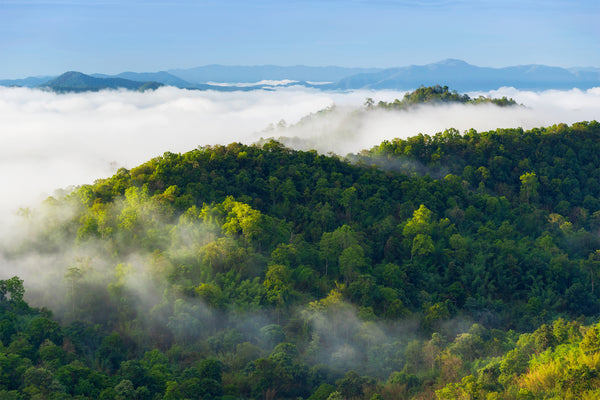Is New York State’s Hudson Valley the first place that comes to mind when you conjure up the image of ancient forests? If not, then it should be! In 2019, scientists recognized a fossil record of the planet’s oldest forest in an unlikely place: an abandoned quarry in Cairo, New York. The forest is believed to be 385 million years old, which is 2-3 million years older than what was previously thought to be the oldest. For context, that’s about 140 million years older than the first dinosaurs that roamed the earth!
These rocks contain the fossilized roots of dozens of giant trees that formed an ancient forest, which probably stretched into Pennsylvania and beyond. When these large root systems formed, they helped pull carbon dioxide (CO2) from the air and lock it away, profoundly altering Earth’s atmosphere and creating the conditions for life as we know it. Scientists believe that a flood killed most of these trees and preserved the root system as fossils.
Aerial Footage of the Fossilized Forest
Why is this Discovery Significant?
This discovery suggests that modern plants evolved much earlier — and have therefore had an earlier impact on Earth’s climate and ecology — than previously thought. Scientists are very meticulous when it comes to reconstructing history through Earth’s fossil record, but this is only the 3rd forest ever discovered that’s from the mid-Devonian period.
What particularly excited paleobotanists about this site is the root systems, which are much larger and more intricate than previously known to exist this early in Earth’s history. Why is that a big deal? According to Kevin Boyce, a geoscientist at Stanford University, trees like those discovered in Cairo, NY had a profound effect on the ancient climate. Their deep roots penetrated and broke down the rocks underneath the soil surface in a process called “weathering.” In turn, this triggered chemical reactions that pulled CO2 from the atmosphere. As a result of this and other factors, atmospheric CO2 levels dropped to modern levels soon after the emergence of woody forests.
With permanent changes to ecology, carbon dioxide levels, and climate, the origin of trees and forests during the mid-Devonian Period was a turning point in Earth’s history.

Ancient Tree Root Fossils (c) Town of Cairo, NY
Let’s take a walk down prehistoric memory lane
Finding well-preserved fossils from long-gone root systems is basically the holy grail if you’re a paleobotanist. But the real appeal for your everyday nature-lover is the opportunity to look back and marvel at how our world and ecosystems came to be — and just how important of a role trees have played in its origin story.
We all know that life on Earth began in the vast oceans, and that’s true for plants as well. The first plants began to colonize land around 430 million years ago, but it took some time for them to evolve and become the complex living organisms we know today. Evolutions like developing vascular tissue, roots, and the ability to reproduce by seed were the critical stepping stones for not only the development of what we now know as trees, but also the creation of soil and the concurrent evolution of insects, vertebrates, and other organisms that relied on these plants.
Biodiversity didn’t just appear fully formed in some grand entrance of creation, it happened very slowly over millions of years, quite literally starting from single cells and learning to become something greater, one tiny step at a time.

Ancient Tree Root Fossils (c) Town of Cairo, NY
The evolutionary cradle of the Devonian and Carboniferous periods
The newly discovered fossil forest is from the mid-Devonian period, which lasted from 416 million to 358 million years ago, and was the 4th period of the Paleozoic era. It came before the better-known Carboniferous period, which was when enormous trees and forests dominated the landscape, increasing atmospheric oxygen from 21% to 35% and sequestering large amounts of carbon. It is these trees that formed the coal that we use for fuel today.
The lesser-known but no less essential precursor to those climate-altering Carboniferous forests, the Devonian period is when plants really started to form Earth’s first forests. These early groves, which consisted mainly of lycophytes, massive horsetails, and ferns, looked very different from the forests we know today.
It was during the Devonian period that Archaeopteris (the first successful trees) finally evolved, with a softwood trunk that grew sequential rings. The fossils found at Cairo, NY show that Archaeopteris evolved about 2-3 million years earlier than previously thought, and have therefore had a longer impact on Earth’s ecology, geochemical cycles, and atmosphere.
Another specimen in the new discovery is still a bit of an uncertainty, but scientists believe it maybe be part of the class Lycopsida — which are the direct ancestors to all of those carbon-sucking trees of the Carboniferous period. What we know about the Cairo, NY forest is that there were no birds or large animals yet, just primitive insects — and that the trees had fernlike fronds instead of leaves or needles, giving them a hair-like appearance.
The value of today’s 360 perspective
A few million years may not seem like much in the grand scheme of Earth’s history, but it’s very significant to how scientists account for the evolution of trees and their long-term impact on our terrestrial world. It means that the environmental changes that made human life possible were the result of a longer, slower process than previously realized.
The verdict? Trees are incredible beings that connect us to a time, eons before humans existed, when Earth’s atmosphere and terrestrial landscape were profoundly different. Discoveries like this remind us of just how extraordinary our planet is — and that trees and forests are the key to life as we know it!
